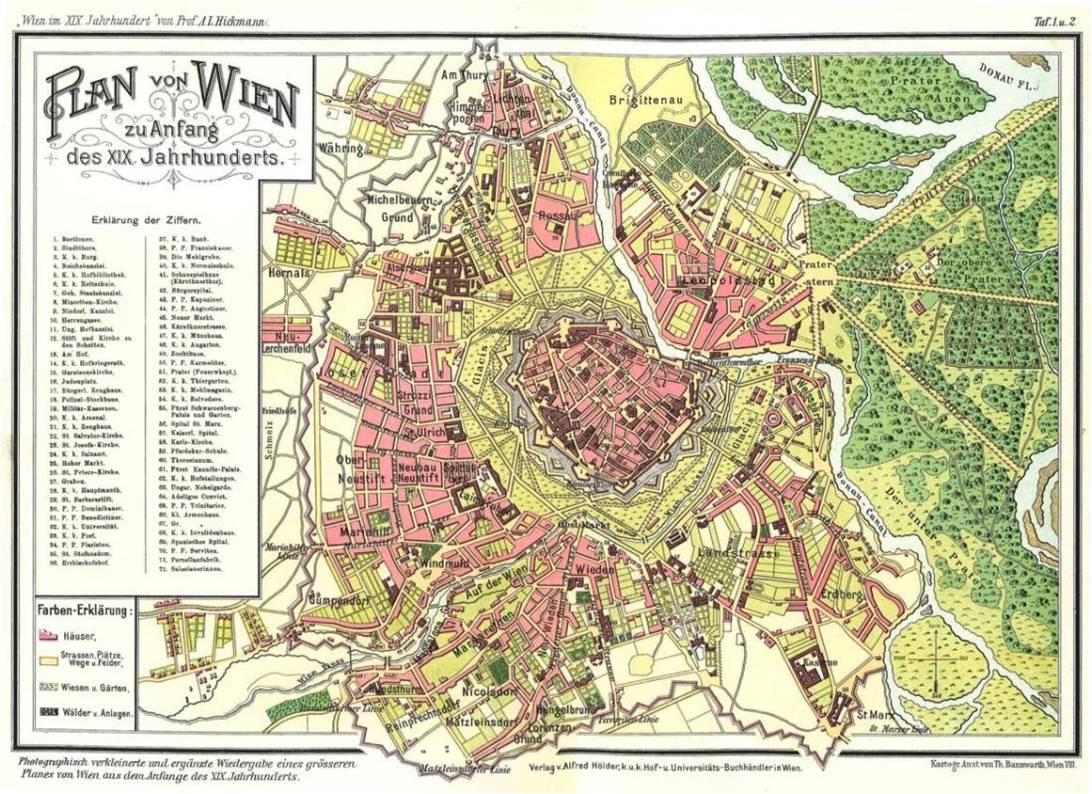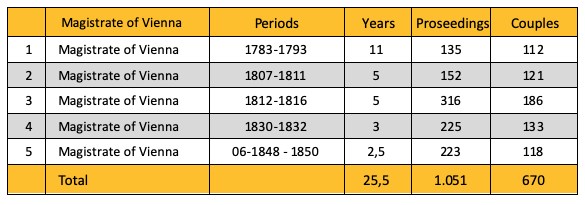1. Court
2. Sources
3. Periods
1. Courts
For the citizens of the city of Vienna the Senate in judicialibus civilibus (Civil Justice Senate) acted as the marriage court from November 1, 1783 onwards. It was one of the three departments of the Magistrate of the Imperial Capital and Residence City Vienna (Magistrats der kaiserlichen Haupt- und Residenzstadt Wien) installed in the early 1780s. Its territorial jurisdiction included the Inner City as well as the suburbs located between the Glacis and the Linienwall (now referred to as the Gürtel, or Belt).
The Civil Justice Senate met in the (old) town hall on Wipplingerstraße until 1839, and from 1839 on the Hohen Markt. In 1841 the Civil Justice Senate was renamed to Magistrate Civil Court.
2. Sources
The divorce files of the Viennese Civil Justice Senate negotiated between 1783 and 1850 are now stored in the Municipal Archive of Vienna and are divided into 52 cartons in total. Depending on whether the subject of litigation was a consensual or a non-consensual divorce, the dossiers of the divorce proceedings contain some of the following documents: parish reports, complaints, minutes from hearings, divorce settlements, correspondence with other authorities, assertions, as well as questionings, witness statements, sentences or judgments including motives and also, in some cases, documents of evidence provided by the parties involved. The more recent the records are the greater is the volume and extent of the files. This also applies to the additional proceedings pertaining to the regulation of the consequences of the divorce.
The composition and organisation of the archive material led, on the one hand, to the conclusion that not all of the written documents produced during the proceedings were archived, and on the other hand, to the assumption that the document dossiers were subsequently “thinned out”.
The structure of the archiving of court records was already described in a Court Order from 1785. After the court proceedings were completed the written documents which had been submitted to the court and had not been returned to the disputing parties, as well as the trial records, were to be “handed over to the registrar’s office”. Each document was to be given a number which identified the legal material of the case, as well as a consecutive number.
Today the court records are, for the most part, still ordered in this fashion. The written documents are placed together or bound into document dossiers which lie in cartons ordered according to years. The extent and density of the documentation of the individual court proceedings varies greatly. Whether the document dossier holds only one sheet of paper or a pile of papers bound together with a string, essentially depended on which documents were drawn up in the context of the court proceedings and which of those were archived.
It was predominantly the older document dossiers, those compiled before the 1830s, which were “thinned out”, meaning that mainly only the documents concerning the decisions and legal consequences of the divorce from bed and board were preserved.
The course and turns which the divorce proceedings took clearly had an effect on the type and number of documents produced during the proceedings. In general, one can say that from the uncontested divorces the petition for divorce and the required certificate from the priest, in which he confirmed that he had attempted to achieve the reconciliation of the married parties, still exist. The court ruling does not exist as its own separate written document, but rather was usually noted next to or above the Rubrum on the request for an uncontested divorce.
From the contested divorce proceedings there are generally the complaint as well as the priest’s certificate and, depending on if the disputing parties settled upon a separation from bed and board or were divorced through a decision of court, either a notification including the settlement made or the verdict including reasons exists. The document dossiers of the divorce proceedings which were decided upon in court can also include the minutes of the oral testimonies, pieces of evidence, list of questions, oath phrases, a records list, extracts from documents, the vote as well as the verdict and its corresponding motivation.
The particularly informative minutes from the hearings have been passed down seamlessly only for the end of our investigation period. That these minutes were produced also in the end of the 18th century is proven by the existence of a fragment from 1787, which contains parts of the exception and the rejoinder of the defendant. The minutes from a few hearings also still exist from 1816 and the 1830s.
Pieces of evidence, for example, private letters, doctor’s reports, testimonies from neighbours, or certificates from employers, are usually missing. It would appear that these were most likely reclaimed by the disputing parties after the court proceedings were completed and are, for this reason, not to be found in the document files.
Some wives and husbands (seldom both disputing parties) submitted an appeal against the verdict of the magistrate. In such cases the second instance verdict of the Lower Austrian Court of Appeal was attached to the divorce dossier. If the proceedings continued to the third, and last, instance, the verdict of the supreme court authorities was also included in the dossier. The work of both of these judicial institutions can, to a certain extent, be understood using these documents. In 1927 a fire in the Palace of Justice destroyed the majority of the existing source material of these institutions.
3. Periods
Just as was the case for the matrimonial proceedings under the jurisdiction of the church, not all matrimonial proceedings for the time period after 1783 could be investigated. The more recent court dossiers from the 1830s and 1840s in particular are very voluminous, making an exhaustive survey impossible. We therefore divided the time period from 1 November 1783 to 30 June 1850, in which the Vienna Magistrate had jurisdiction over matrimonial disputes, into 5 investigation periods, which were also oriented on changes in legal procedure. From the approximately 60 years in which the magistrate had jurisdiction over matrimonial proceedings, the divorce and divorce consequence proceedings were investigated over a time period of 25.5 years.
As already mentioned above, the matrimonial proceedings are not handed down in record books as was the case before 1783, but rather as files, pooled together into one dossier. The dossier documented the legal disputes of the couple, and generally included all documents which were produced within the context of one or more connected matrimonial proceedings. The dossier also included the written documentation of official administration work which was carried out after 1 July 1850 as other courts were already responsible for matrimonial affairs.
The following table gives an overview of the periods of investigation, number of proceedings examined and couples concerned.
The first investigation period spans the first ten years after the Josephinian Marriage Patent came into effect, and covers the time period from 1 November 1783 until the end of 1793. Within this investigation period the first legal change was introduced. In 1786, three years after the prohibition of contested divorce from bed and board and a massive decrease in matrimonial proceedings, the contested divorce proceedings were once again permitted. However, this only on the condition that the other part of the marriage “maliciously” refused to consent to the divorce.
The second investigation period spans from 1807 to 1816 and concentrates on the practical effects of the changes and reforms regarding matrimonial affairs brought about by the implementation of the General Civil Law Code (ABGB) of 1811. The years from 1830 to 1832 and from 1848 to 1850 were chosen as the third and fourth investigation periods.
Georg Tschannett 2016, translation Jennifer Blaak
Last update: Andrea Griesebner, December 2020


